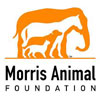Cardiac Guidelines for Breeders
A careful clinical examination that emphasizes cardiac auscultation is the
most expedient and cost-effective method for identifying Congenital Heart
Disease in dogs. While there are exceptions, virtually all common congenital
heart defects are associated with the presence of a cardiac murmur. Consequently,
it is recommended that cardiac auscultation be the primary screening method
for initial identification of CHD and the initial classification of dogs.
Murmurs related to CHD may at times be difficult to distinguish from normal,
innocent (also called physiologic or functional) murmurs. Innocent cardiac
murmurs are believed to the related to normal blood flow in the circulation.
Innocent murmurs are most common in young, growing animals. The prevalence
of innocent heart murmurs in mature dogs (especially in athletic dogs) is
undetermined. A common clinical problem is the distinction between innocent
murmurs and murmurs arising from CHD.
Definitive diagnosis of CHD usually involves one or more
of the following methods:
- Echocardiography with Doppler studies
- Cardiac catheterization with angiocardiography
- Post-mortem examination of the heart (necropsy).
Other methods of cardiac evaluation, including electrocardiography and
thoracic radiography, are useful in evaluating individuals with CHD, but
are not sufficiently sensitive nor specific to reliably identify or exclude
the presence of CHD.
- The noninvasive method of echocardiography with Doppler is the preferred
method for establishing a definitive diagnosis in dogs when CHD is suspected
the clinical examination. Echocardiography is an inappropriate screening
tool for the identification of congenital heart disease and should be
performed only when the results of clinical examinations suggest a definite
or potential cardiovascular abnormality.
- Two-dimensional echocardiography provides an anatomic image of the
heart and blood vessels. While moderate to severe cardiovascular malformations
can generally be recognized by two-dimensional echocardiography, mild
defects (which are often of great concern to breeders of dogs) may not
be identifiable by this method alone.
- Doppler studies, including pulsed-wave and continuous wave spectral
Doppler, and two-dimensional color Doppler demonstrate the direction
and velocity of blood flow in the heart and blood vessels. Abnormal
patterns of blood flow are best recognized by Doppler studies. Results
of Doppler studies can be combined with those of the two-dimensional
echocardiogram in assessing the severity of CHD. Color Doppler echocardiography
is used to evaluate relatively large areas of blood flow and is beneficial
in the overall assessment of the dog with suspected CHD. Turbulence
maps employed in color Doppler imaging are useful for identifying high
velocity or disturbed blood flow but are not sufficiently specific (or
uniform among manufacturers) to quantify blood velocity. It is emphasized
that quantitation of suspected blood flow abnormalities is essential
and can only be accomplished with pulsed or continuous wave Doppler
studies. Pulsed wave and continuous wave Doppler examinations provide
a display of blood velocity spectra in a graphical format and are the
methods of choice for assessing blood flow patterns and blood flow velocity
in discrete anatomic areas.
- Cardiac catheterization is an invasive method for identification
of CHD that is considered very reliable for the diagnosis of CHD. Cardiac
catheterization should be performed by a cardiologist, usually requires
general anesthesia, carries a small but definite procedural risk, and
is generally more costly than noninvasive studies. While cardiac catheterization
with angiocardiography is considered one of the standards for the diagnosis
CHD, this method has been supplanted by echocardiography with Doppler
for routine evaluation of suspected CHD.
- Necropsy examination of the heart should be done in any breeding
dog that dies or is euthanized The hearts of puppies and dogs known
to have cardiac murmurs should always be examined following the death
of the animal. A post mortem examination of the heart is best done by
a cardiologist or pathologist with experience in evaluating CHD. While
it is obvious that necropsy cannot be used as a screening method, the
information provided by this examination can be useful in guiding breeders
and in establishing the modes of inheritance of CHD.
Limitations
Each of the methods of evaluation indicated above may be associated with
false positive and false negative diagnoses. It must be recognized that
some cases of CHD fall below the threshold of diagnosis. In other cases,
a definitive diagnosis may not be possible with currently available technology
and knowledge. These limitations can be minimized by considering the following
general guidelines:
- The results to the examinations described above are most reliable
when performed by an experienced individual with advanced training
an experience in cardiovascular diagnosis. Echocardiography with Doppler,
cardiac catheterization, and post-mortem examination of the heart
for CHD requires advanced training in cardiovascular diagnostic methods
and the pathology and pathophysiology of CHD.
- Examinations performed in mature dogs are most likely to be definitive.
This is especially true when considering mild congenital heart defects.
Innocent heart murmurs are less common in mature animals than in puppies
are less likely to be a source of confusion. Furthermore, the murmurs
associated with some mild congenital malformations become more obvious
after a dog has reached maturity. While it is quite reasonable to
perform preliminary evaluations and provide provisional certification
to puppies and young dogs between 8 weeks and 1 year of age, final
certification, prior to breeding, should be obtained in mature dogs
at 12 months of age or older.
- Examination conditions must be appropriate for recognition of subtle
cardiac malformations. Identification of soft cardiac murmurs is impeded
by extraneous noise or by poorly restrained, anxious, or panting dogs.
- A standardized cardiac clinical examination must be performed according
to a predetermined and clearly communicated protocol. Physical examination
and cardiac auscultation should be used as the initial method of cardiac
evaluation. If the clinical (as indicated above).
- Examiners who perform echocardiography with Doppler must use appropriate
ultrasound equipment, transducers, and techniques. Such individuals
should have advanced training in noninvasive cardiac diagnosis and
should follow diagnostic standards established by their hospital and
by the veterinary scientific community, including standards published
by the American College of Veterinary Internal Medicine, specialty
of Cardiology (J Vet Internal Med 1993;7:247-252).




